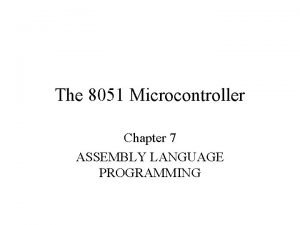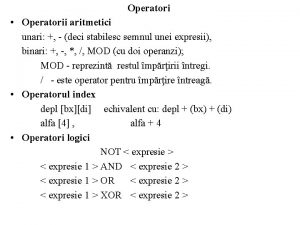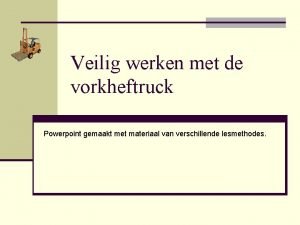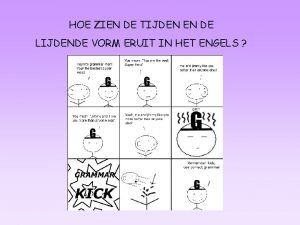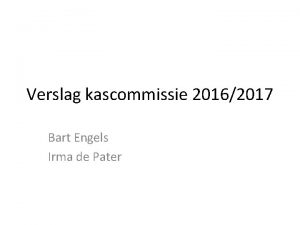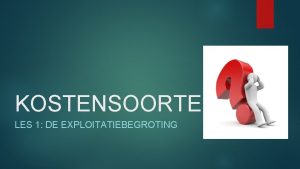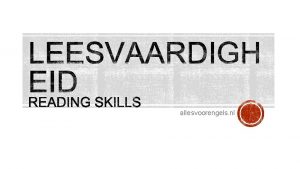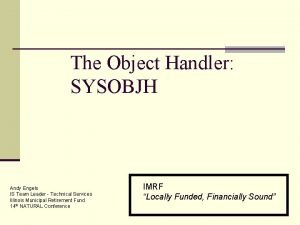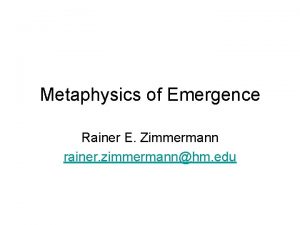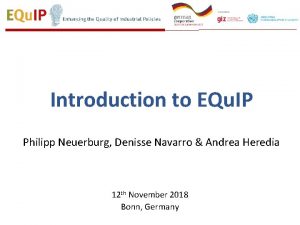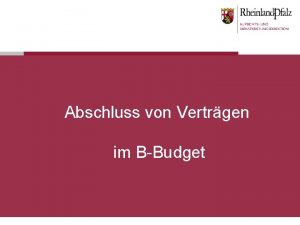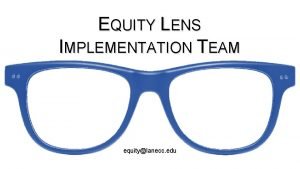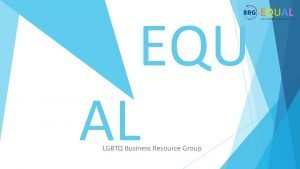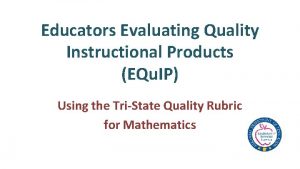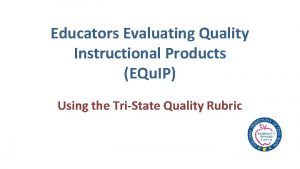Introduction to EQu IP Rainer Engels 5 th
















- Slides: 16

Introduction to EQu. IP Rainer Engels 5 th of December 2018 Bonn, Germany

Industrial Policy is back on the agenda § The question is no longer whether or why industrial policies should be deployed in the first place, but “what”, “when” and “how” they can be designed and implemented more effectively. § The scope of the strategies has broadened beyond a focus on growth and must now consider an integrated social, environmental and economic landscape of interventions. 2

What is Industrial Policy? EQu. IP definition: “Government promotion of structural transformation through support of economic activities that are perceived to be socially beneficial” What type of structural transformation? What is socially beneficial? 3

As a result… § There is a large dependency on external advice (development partners or national experts/consultants) § Policy design often begins with “one-size-fits all” instruments rather than objectives. § Lack of consideration for broader national development context: industrial policy is not aligned with other policy areas. § Lack of ownership (and full understanding) of analytical results, which often inhibits fully devoted course of actions § Contradictions between different pieces of analytics & advice 5

…since 2014! www. equip-project. org 7

How to make Industrial Policy effective? GOAL-ORIENTED (BE STRATEGIC!) EVIDENCE-BASED SELF-DETERMINED (TAKE CONTROL!) (STAY INFORMED!) EFFECTIVE INDUSTRIAL POLICY 8

As a result… Traditional approach EQu. IP approach (self-determined) Objective: Best possible policy document Self-sufficient policy-making process Responsibility: International expert taking lead Building local capacities for industrial policy design Priorities: growth and export competitiveness Recognize multi-dimensional nature of development Challenge: limited implementation, no sustainability Fully owned policy that will be implemented 9

EQu. IP 1. Industrial Analysis: Overview of tools 13

EQu. IP Industrial Policy design “The conscious attempt to define industrial policy objectives and connect them to the industrial policy instruments expected to realize those objectives” IP Objectives IP Instruments • What kind of structural transformation? • Economic, social and environmental considerations • • Regulations Incentives Information Public ownership 18

EQu. IP 2: From Analysis to Industrial Policy Design Analytical foundations from EQu. IP 1 The EQu. IP 2 industrial policy design process 1 Link IP to National Development Goals 2 Define industrial policy objectives 3 Select intervention areas & target groups 4 Consider industrial policy instruments 19

EQu. IP examples of IP objectives INCREASE PRODUCTIVE ACTIVITIES DEEPEN GLOBAL MARKET INTEGRATION MAXIMIZE DOMESTIC BENEFITS GENERATE PRODUCTIVE EMPLOYMENT IMPROVE QUALITY OF EMPLOYMENT ENSURE EQUITABLE PRODUCTION BUILD ECONOMIC RESILIENCE PROMOTE SELF-SUFFICIENCY IMPROVE RESOURCEEFFICIENCY REDUCE POLLUTION • EQu. IP: There is no single “right” IP objective! • Objectives have to be defined on the basis of national context and will shape the structural transformation pattern 22

4 types of policy instruments REGULATIONS INCENTIVES Formulated rules and directives that mandate economic actors to act in accordance The handing out or taking away of material resources to encourage certain behaviors by economic actors INFORMATION The collection, dissemination and publication of information to promote particular economic activities PUBLIC OWNERSHIP Government’s establishment of enterprises and direct supply or demand of particular goods & services. 25

EQu. IP in the policy cycle CONDUCTING INDUSTRIAL DIAGNOSIS MONITORING & EVALUATING POLICY IMPACT Institutional Set-up IMPLEMENTING INDUSTRIAL POLICY INSTRUMENTS DEFINING STRATEGIC PRIORITIES DESIGNING AN INDUSTRIAL POLICY PACKAGE 26

EQu. IP in Action § East African Community: Building analytical capacity of member states to assess industrial performance § Mozambique: Review industrial strategy draft and establish monitoring system § Ukraine: Facilitate drafting of new industrial policy § Vietnam: Conduct assessment of priority sector’s performance (textiles, machinery & agro-processing) § Myanmar: Support with drafting of new Textile strategy and action plan § South Africa: Design M&E system to assess impact of large subsidy scheme for manufacturer’s 32

Different applications for EQu. IP Need for new industrial policy Develop an industrial policy that reflects countries unique context, priorities and capacities Self-dependency to conduct diagnostics to identify opportunities and options that can be considered in the process Review / update industrial policy Assess the strategic orientation of an existing industrial policy and instruments Identify which instruments should be kept, changed and terminated Industrial policy in place Use this process to check the consistency of the policy package Develop monitoring and evaluation framework for industrial policy Align new IP instruments and donor interventions better to national priorities 33

How to use EQu. IP in a partner country • The country can ask German government through GIZ to support • Existing bilateral GIZ programs (short term perspective as well as long term) • Sectoral GIZ programs at headquarters (e. g. combine investment promotion with industrial policy development in Mongolia) • Global GIZ programs can support (e. g. job partnerships in Africa, Mediterranean and Near East, could apply for Ethiopia) • GIZ headquarters programs commission UNIDO (actually one training in preparation!) • The country could finance GIZ to support (International Services) • The country could finance UNIDO to support • The country could hire EQu. IP trainers directly • Other donors could use EQu. IP (EU, negotiations with Af. DB have started)
 Chemical rxns/balancing equ./stoichiometry
Chemical rxns/balancing equ./stoichiometry Equ in 8051
Equ in 8051 Cor root word examples
Cor root word examples Directiva equ
Directiva equ Literal table stores
Literal table stores Adjusted body weight formula
Adjusted body weight formula Gevarendiamant
Gevarendiamant Hansje pansje kevertje engels
Hansje pansje kevertje engels Engels model of grief
Engels model of grief Leestekens schema
Leestekens schema Lijdende vorm engels
Lijdende vorm engels Engels 6 stages of grief
Engels 6 stages of grief Wat is rmna
Wat is rmna Exploitatiebegroting engels
Exploitatiebegroting engels Lauren engels
Lauren engels Gouden tip'' in het engels
Gouden tip'' in het engels Andy engels
Andy engels

